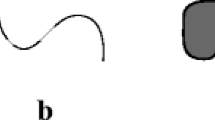Abstract
Recently there is much interest in moving objects databases, and data models and query languages have been proposed offering data types such as moving point and moving region together with suitable operations. In contrast to most earlier work on spatio-temporal databases, a moving region can change its shape and extent not only in discrete steps, but continuously. Examples of such moving regions are oil spills, forest fires, hurricanes, schools of fish, spreads of diseases, or armies, to name but a few.
Whereas the database will contain a “temporally complete” representation of a moving region in the sense that for any instant of time the current extent and shape can be retrieved, the original information about the object moving around in the real world will most likely be a series of observations (“snapshots”). We consider the problem of constructing the complete moving region representation from a series of snapshots. We assume a model where a region is represented as a set of polygons with polygonal holes. A moving region is represented as a set of slices with disjoint time intervals, such that within each slice it is a region whose vertices move linearly with time. Snapshots are also given as sets of polygons with polygonal holes. We develop algorithms to interpolate between two snapshots, going from simple convex polygons to arbitrary polygons. The implementation is available on the Web.
Access this chapter
Tax calculation will be finalised at checkout
Purchases are for personal use only
Preview
Unable to display preview. Download preview PDF.
Similar content being viewed by others
References
M. H. Böhlen, R. H. Güting, M. Erwig, C. S. Jensen, N. A. Lorentzos, M. Schneider, and M. Vazirgiannis, A Foundation for Representing and Querying Moving Objects. ACM Transactions on Database Systems 25:1 (2000), pp. 1–42.
T. S. Cheng and S. K. Gadia, A Pattern Matching Language for Spatio-Temporal Databases. In Proc. ACM Conf. on Information and Knowledge Management, pp. 288–295. 1994.
J. Chomicki and P. Revesz, Constraint-Based Interoperability of Spatio-Temporal Databases. In Proc. 5th Int. Symp. on Large Spatial Databases, pp. 142–161, Berlin, Germany, 1997.
J. Chomicki and P. Revesz, A Geometric Framework for Specifying Spatiotemporal Objects. In Proc. 6th Int. Workshop on Temporal Representation and Reasoning (TIME), pp. 41–46, 1999.
L. Forlizzi, R. H. Güting, E. Nardelli, and M. Schneider, A Data Model and Data Structures for Moving Objects Databases. Proc. ACM SIGMOD Int. Conf. on Management of Data, Dallas, Texas, pp. 319–330, 2000.
R. L. Graham, An Efficient Algorithm for Determining the Convex Hull of a Finite Planai Set. Information Processing Letters 1 (1972), pp. 132–133.
D. J. Peuquet and N. Duan, An Event-Based Spatiotemporal Data Model (ESTDM) for Temporal Analysis of Geographical Data. Int. Journal of Geographical Information Systems 9:1 (1995), pp. 7–24.
F. P. Preparata and M. I. Shamos, Computational Geometry: An Introduction. Springer-Verlag, New York, 1985.
T. W. Sederberg and E. Greenwood: A Physically Based Approach to 2-D Shape Blending. Computer Graphics (Proc. ACM SIGGRAPH) 26:2 (1992), pp 25–34.
A. P. Sistla, O. Wolfson, S. Chamberlain and S. Dao: Modeling and Querying Moving Objects. Proc. Int. Conf. on Data Engineering, pp. 422–432, 1997.
E. Tossebro and R. H. Güting, Creating Representations for Continuously Moving Regions from Observations. FernUniversität Hagen, Informatik-Report, in preparation, 2001.
M. F. Worboys, A Unified Model for Spatial and Temporal Information. The Computer Journal 37:1 (1994), pp. 25–34.
Author information
Authors and Affiliations
Editor information
Editors and Affiliations
Rights and permissions
Copyright information
© 2001 Springer-Verlag Berlin Heidelberg
About this paper
Cite this paper
Tøssebro, E., Güting, R.H. (2001). Creating Representations for Continuously Moving Regions from Observations. In: Jensen, C.S., Schneider, M., Seeger, B., Tsotras, V.J. (eds) Advances in Spatial and Temporal Databases. SSTD 2001. Lecture Notes in Computer Science, vol 2121. Springer, Berlin, Heidelberg. https://doi.org/10.1007/3-540-47724-1_17
Download citation
DOI: https://doi.org/10.1007/3-540-47724-1_17
Published:
Publisher Name: Springer, Berlin, Heidelberg
Print ISBN: 978-3-540-42301-0
Online ISBN: 978-3-540-47724-2
eBook Packages: Springer Book Archive




